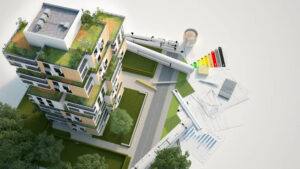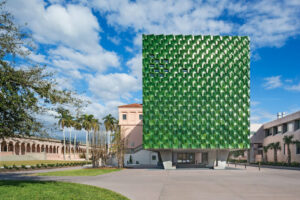Welcome to the dawn of a new era in architectural design! As we step into 2024, let’s explore the cutting-edge trends shaping the landscape of our profession. Buckle up, because this year promises to be a thrilling ride filled with innovation, sustainability, and technological advancements.
1. Biophilic Design:
Nature-inspired architecture continues to gain momentum, with biophilic design at its forefront. Integrating natural elements like greenery, sunlight, and water features into our structures not only enhances aesthetics but also promotes well-being.
According to a recent survey by the American Institute of Architects, 79% of architects reported an increase in client requests for biophilic design elements.
To learn more about the principles of biophilic design consider reading this article.

2. Adaptive Reuse:
Sustainability takes center stage as architects embrace the challenge of repurposing existing structures. Adaptive reuse not only reduces environmental impact but also preserves architectural heritage.
A study by the World Green Building Council found that adaptive reuse projects can reduce carbon emissions by up to 50% compared to new construction.
What are the advantages of adaptive reuse?
Reduce building costs: When compared to standard building projects, adaptive reuse offers significant financial benefits and cost reductions. Adaptive reuse generally requires more labor than building materials, and while material costs have surged in recent decades, labor costs have only slightly increased.
Adaptive reuse also eliminates all demolition costs, which are frequently expensive and consume a large percentage of a construction budget. Local tax breaks and federal historic tax credits for the adaptive reuse of buildings alleviate financial concerns for builders renovating historic structures.

Accelerates construction: Building a new structure typically takes far longer than rehabilitating an existing building. Many sections in an ancient building may be habitable with only minor renovations, so even if the project is still ongoing, owners can open up parts of the property for business.
Popular throughout the community: Creative adaptive reuse projects are extremely popular in communities because people value the historical preservation of notable buildings in their neighborhood as well as the creation of new, distinctive landmarks. If you’re a commercial builder, reusing an older building can help drive client interest in your company, whether it’s a restaurant, an apartment building, or a shopping mall.
3. Smart Buildings:
The rise of the Internet of Things (IoT) has ushered in an era of smart buildings that are not only energy-efficient but also responsive to occupants’ needs. From automated lighting and HVAC systems to integrated security features, smart technology is revolutionizing the way we design and inhabit spaces. According to a report by MarketsandMarkets, the smart building market is projected to reach $109.48 billion by 2026.
4. Modular Construction:
Speed, efficiency, and flexibility define the rise of modular construction techniques. Prefabricated components allow for faster assembly on-site while minimizing waste. With the global construction industry facing labor shortages and cost pressures, modular construction offers a viable solution. McKinsey & Company estimates that modular construction could reduce project schedules by up to 50%.
5. Carbon-Neutral Design:
With climate change looming large, architects are increasingly focused on achieving carbon-neutral or even carbon-negative design outcomes. Innovations in materials, construction techniques, and renewable energy systems are driving this shift towards sustainable architecture. As architects, we have a responsibility to mitigate our carbon footprint and design for a greener future.
Learn how the groundbreaking innovation Litheoz UHPFRC (German technology) developed in India, is becoming architects’ choice for interiors and exteriors.
6. Virtual Reality in Design Process:
Virtual reality (VR) technology is revolutionizing the design process, allowing architects to visualize and experience spaces before they are built. By immersing clients in virtual environments, architects can gather real-time feedback and make informed design decisions. According to a survey by the Royal Institute of British Architects, 72% of architects believe that VR will become a common tool in architectural practice within the next five years.
Advantages of VR in architectural design:
One advantage of virtual reality in architecture is that it can be rendered at various Levels of Detail (LOD), allowing an architect in the early design process to have an immersive experience in a non-photorealistic room to gain an understanding of spatial connections and massing. Alternatively, the experience may be hyperreal, with a VR film showing soft sunshine flowing down through a clerestory window and birds chirping outside.
Architects are increasingly combining virtual reality (VR) devices like the HTC Vive and Oculus with building information modeling (BIM) software. “This will allow architects and clients alike to truly understand the spatial qualities of the project,” says Kim Baumann Larsen, architect and CEO of Dimension Design, an AR/VR design and consulting firm. “This spatial understanding should make clients more confident in the design and reduce time spent in meetings and the use of lateral design revisions.”
End Note
In conclusion, 2024 promises to be a year of innovation and transformation in the field of architectural design. By embracing biophilic principles, sustainable practices, and technological advancements, one can create spaces that not only inspire awe but also promote human well-being and environmental stewardship.
In Nuance Studio, we are always incorporating designs that are inspired by nature to meet architects’ aspirations. Developing evergreen premium quality concrete for both indoors and outdoors, Nuance stands for Let’s dare to dream, innovate, and shape the future of architecture together!

